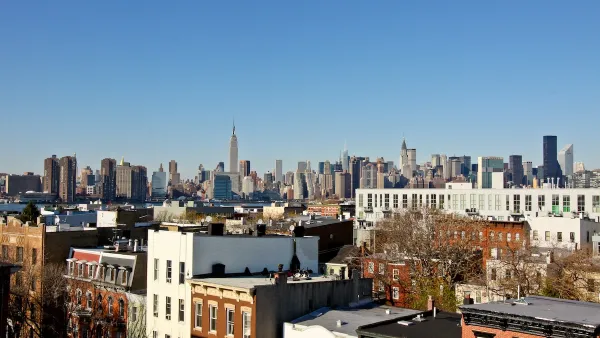In Joel Kotkin's new book The Human City, he argues that suburbanization promotes higher birthrates. But this policy doesn't seem to have worked so far.

In his new book The Human City, Joel Kotkin correctly points out that the more affluent parts of the world are facing a "Birth Dearth": birth rates have declined and populations have rapidly aged, which means that in the future, there may not be enough working-age taxpayers to support old-age retirement programs and other social programs. He also correctly notes that urban cores tend to have fewer children and smaller families than suburbs. He therefore concludes that "[w]ithout places for people to move farther out in the periphery, these core cities, with their low birth rates… are hardly sustainable in the long run." In other words, Kotkin's logic seems to be something like this:
Assumption 1: Society needs more children.
Assumption 2: Society cannot have more children without continued suburbanization, because parents will never again be willing to bring up children in cities.
Assumption 3: By contrast, parents are willing to bring up children in suburbia.
Conclusion: Therefore, suburbanization is necessary for more children.
However, both Assumption 2 and Assumption 3 are highly questionable.
Kotkin correctly notes that housing prices have exploded in big cities, and admits that "middle-income housing affordability constitutes a huge constraint on family formation in many cities… Virtually all of the countries with ultra-low birth rates [ ] suffer from very high housing prices." Thus, housing prices have driven middle-class families out of the world's more desirable cities. (Since Kotkin's book is not really focused on declining, low-demand cities, I shall not focus on their problems in this essay.)
But it doesn't follow from this that cities can never be family-friendly. Instead, it follows that if urban housing prices were lower, cities would become more popular with families. Since prices tend to be governed by the law of supply and demand, it further follows that a smart growth strategy of allowing more housing construction in cities would make cities more appealing to families.
However, current law precludes such policies; the most expensive cities often have zoning rules that are more restrictive than those of the typical American city. For example, in most American cities, city councils have veto power over rezoning. But New York City adds other possible choke points by giving borough presidents the right to review rezoning, and by creating community boards which also have the right to comment on development proposals. Finally, the city bureaucracy on its own can propose downzoning a neighborhood, which means that the zoning code permits even less new housing than in the past. (In the mid-2000s, the city downzoned 40,000 parcels of land.) Similarly, San Francisco has unusually restrictive zoning policies. For example, San Francisco allows the city bureaucracy to veto even development that conforms to the existing zoning code. Because zoning laws artificially limit urban housing supply (and thus increase urban housing prices) it seems to me that zoning deregulation would increase the housing supply and thus reduce housing prices, thus making cities more family-friendly. So one might think that Kotkin would favor allowing more housing in existing city neighborhoods.
But more housing in a neighborhood means, by definition, that the neighborhood becomes a little more dense. And Kotkin does not approve of density, writing that "higher-density housing is far more expensive to build… [because] the cost of developing a garden apartment is roughly one-third that of developing a high-rise." But Kotkin's claim is based on a false dichotomy: he implies that "higher-density housing" is the same as high-rises, and thus that new housing must either be low-density suburbia or high-rises. In fact, urban housing can be quite dense (and family-friendly) without being high-rise. Kotkin of all people should know this, since he writes that his father grew up in Brooklyn’s Flatbush neighborhood when it was "very much a place for middle-class families," and describes the nearby Ditmas Park neighborhood as one where people move "to escape a culture dominated by childless people." These low-rise neighborhoods are hardly low-density suburbs: both Flatbush and Ditmas Park have between 65,000 and 68,000 people per square mile (nearly twice the Brooklyn average).
If most cities built neighborhoods as dense as Ditmas Park, there would be no need for suburbs (or for that matter, high rises). For example, if all of New York City was built at the density of Ditmas Park, it could accommodate 20.3 million people- more than twice its current population, and roughly the population of the entire New York metropolitan area.
Kotkin's second major assumption is that because suburbs have more families than cities, more suburbs mean more babies. But Kotkin also notes that suburbs have grown faster than urban cores, both in the United States and Europe. So if suburbs are growing everywhere and suburbs are good for children, therefore we should see rising birth rates everywhere, especially in the suburb-dominated United States.
But in fact, the opposite has occurred. In 1950, at the dawn of the suburban era, the birth rate (that is, the number of births per 1000 people) was 24.1; in 2013, the same number was 12.5. Similarly, the fertility rate (the number of live births for women between 15 and 44) declined from 106.2 per 1000 women to 62.9. (European birthrates have declined to a roughly similar extent).
Someone in 1950 might have bet that the suburban experiment would protect the United States and other affluent nations from declining fertility. But the verdict of history is in. Suburbia failed.

Maui's Vacation Rental Debate Turns Ugly
Verbal attacks, misinformation campaigns and fistfights plague a high-stakes debate to convert thousands of vacation rentals into long-term housing.

Planetizen Federal Action Tracker
A weekly monitor of how Trump’s orders and actions are impacting planners and planning in America.

In Urban Planning, AI Prompting Could be the New Design Thinking
Creativity has long been key to great urban design. What if we see AI as our new creative partner?

King County Supportive Housing Program Offers Hope for Unhoused Residents
The county is taking a ‘Housing First’ approach that prioritizes getting people into housing, then offering wraparound supportive services.

Researchers Use AI to Get Clearer Picture of US Housing
Analysts are using artificial intelligence to supercharge their research by allowing them to comb through data faster. Though these AI tools can be error prone, they save time and housing researchers are optimistic about the future.

Making Shared Micromobility More Inclusive
Cities and shared mobility system operators can do more to include people with disabilities in planning and operations, per a new report.
Urban Design for Planners 1: Software Tools
This six-course series explores essential urban design concepts using open source software and equips planners with the tools they need to participate fully in the urban design process.
Planning for Universal Design
Learn the tools for implementing Universal Design in planning regulations.
planning NEXT
Appalachian Highlands Housing Partners
Mpact (founded as Rail~Volution)
City of Camden Redevelopment Agency
City of Astoria
City of Portland
City of Laramie






























